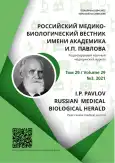Von Willebrand factor in patients with peripheral artery disease who undergo invasive treatment
- Authors: Kalinin R.E.1, Suchkov I.A.1, Mzhavanadze N.D.1, Zhurina O.1, Klimentova E.A.1, Povarov V.1
-
Affiliations:
- Ryazan State Medical University
- Issue: Vol 29, No 3 (2021)
- Pages: 389-396
- Section: Original study
- URL: https://bakhtiniada.ru/pavlovj/article/view/79099
- DOI: https://doi.org/10.17816/PAVLOVJ79099
- ID: 79099
Cite item
Abstract
AIM: To evaluate the level and activity of von Willebrand factor (vWF) in patients with peripheral artery disease (PAD) who underwent endovascular or open bypass grafting.
MATERIAL AND METHODS: The study included 115 patients with chronic lower limb ischemia due to PAD, stage IIb-IV according to A.V. Pokrovsky–Fontaine. Fifty-five participants underwent endovascular treatment, while sixty underwent open bypass procedures using synthetic grafts. Peripheral blood samples were collected from all patients at baseline and three months after invasive treatment to determine the vWF antigen and activity. All patients were monitored every three months for a year to detect the development of unfavorable outcomes including disease progression, restenosis, graft thrombosis, oncology, myocardial infarction (MI), limb loss, stroke, and lethal outcomes.
RESULTS: The highest values of vWF antigen in patients who underwent endovascular treatment were detected in patients with multilevel lesions–1.25 µg/mL (vs 0.2 µg/mL, 95% confidence interval (CI) 0.72–3.21 mcg/mL p = 0.019); with a similar trend observed after a 3–month follow-up. Baseline vWF antigen was higher in endovascular group patients who developed myocardial infarction (MI) within a year following the procedures as compared to those without MI: 1.15 mcg/mL (95% CI 1.05–1.175 mcg/mL) and 0.9 mcg/mL (95% CI 0.78–1.01 mcg/mL), respectively (p = 0.015). Moreover, vWF antigen was increased at the 3-month follow-up in patients with lethal outcomes–1.06 mcg/mL (95% CI 0.96–1.18 mcg/mL, р = 0.031). vWF activity in endovascular group patients with developed MI was four times higher than those without MI (р = 0.022); a similar trend was detected in the development of lethal outcomes (р = 0.009). Those who underwent open bypass grafting presented with high activity of vWF with maximum values detected in participants with proximal iliofemoral lesions (1200%, 95% CI 640%–1200%) and stage IV disease (770%, 95% CI 320%–1200%, p < 0.05). ROC analysis revealed that vWF activity at least 6.2 times higher in patients who underwent endovascular treatment associated with the development of lethal outcomes within one year after invasive treatments; sensitivity and specificity of the method were 83.3% and 75.5%, accordingly.
CONCLUSION: Patients with PAD presented with increased vWF antigen and activity with maximum values detected in patients with multilevel lesions and critical lower limb ischemia. Increased vWF antigen and activity was associated with development of MI and lethal outcomes within one year following endovascular procedures on lower extremity arteries.
Full Text
##article.viewOnOriginalSite##About the authors
Roman E. Kalinin
Ryazan State Medical University
Email: kalinin-re@yandex.ru
ORCID iD: 0000-0002-0817-9573
SPIN-code: 5009-2318
Scopus Author ID: 24331764400
ResearcherId: М-1554-2016
MD, Dr. Sci. (Med.), Professor, specialist of 1 category, Department of training of scientific and pedagogical personnel, intellectual property
Russian Federation, 9, st. High-voltage, Ryazan, 390026Igor A. Suchkov
Ryazan State Medical University
Email: i.suchkov@rzgmu.ru
ORCID iD: 0000-0002-1292-5452
SPIN-code: 6473-8662
Scopus Author ID: 56001271800
ResearcherId: М-1180-2016
MD, Dr. Sci. (Med.), Professor
Russian Federation, 9, st. High-voltage, Ryazan, 390026Nina D. Mzhavanadze
Ryazan State Medical University
Email: nina_mzhavanadze@mail.ru
ORCID iD: 0000-0001-5437-1112
MD, Cand. Sci. (Med.)
Russian Federation, 9, st. High-voltage, Ryazan, 390026Olga Zhurina
Ryazan State Medical University
Email: mail@hemacenter.org
ORCID iD: 0000-0002-2159-582X
MD, Cand. Sci. (Med.)
Russian Federation, 9, st. High-voltage, Ryazan, 390026Emma A. Klimentova
Ryazan State Medical University
Email: rzgmu@rzgmu.ru
ORCID iD: 0000-0003-4855-9068
SPIN-code: 5629-9835
MD, Cand. Sci. (Med.)
Russian Federation, 9, st. High-voltage, Ryazan, 390026Vladislav Povarov
Ryazan State Medical University
Author for correspondence.
Email: ecko65@mail.ru
ORCID iD: 0000-0001-8810-9518
SPIN-code: 2873-1391
MD, Cand. Sci. (Med.)
Russian Federation, 9, st. High-voltage, Ryazan, 390026References
- Strelnikova EA, Trushkina PYu, Surov IYu, et al. Endothelium in vivo and in vitro. Part 1: histogenesis, structure, cytophysiology and key markers. Nauka Molodykh (Eruditio Juvenium). 2019;7(3):450–65. (In Russ). doi: 10.23888/HMJ201973450-465
- Verhenne S, Denorme F, Libbrecht S, et al. Platelet-derived VWF is not essential for normal thrombosis and hemostasis but fosters ischemic stroke injury in mice. Blood. 2015;126(14):1715–22. doi: 10.1182/blood-2015-03-632901
- Löf A, Müller JP, Brehm MA. A biophysical view on von Willebrand factor activation. Journal of Cellular Physiology. 2018;233(2):799–810. doi: 10.1002/jcp.25887
- Lopes da Silva M, Cutler DF. von Willebrand factor multimerization and the polarity of secretory pathways in endothelial cells. Blood. 2016;128(2):277–85. doi: 10.1182/blood-2015-10-677054
- Shepard AD, Gelfand JA, Callow AD, et al. Complement activation by synthetic vascular prostheses. Journal of Vascular Surgery. 1984;1(6):829–38. doi: 10.1016/0741-5214(84)90015-6
- Natsional’nyye rekomendatsii po vedeniyu patsiyentov s zabolevaniyami arteriy nizhnikh konechnostey. Angiology and Vascular Surgery. 2013;19(Suppl):1–68. (In Russ).
- Nowakowski T, Malinowski KP, Nizankowski R, et al. Restenosis is associated with prothrombotic plasma fibrin clot characteristics in endovascularly treated patients with critical limb ischemia. Journal of Thrombosis and Thrombolysis. 2019;47(4):540–9. doi: 10.1007/s11239-019-01826-9
- Fan M, Wang X, Peng X, et al. Prognostic value of plasma von Willebrand factor levels in major adverse cardiovascular events: a systematic review and meta-analysis. BMC Cardiovascular Disorders. 2020;20(1):72. doi: 10.1186/s12872-020-01375-7
- Sokolov EI, Shtin SR, Bayurova NV, et al. Relationship between endotelin-1, von Willebrand factor and platelet status indices in patients with coronary artery disease. Tekhnologii Zhivykh Sistem. 2013;10(6):57–64. (In Russ).
- Kalinin RE, Suchkov IA, Chobanyan AA. Prospects for forecasting the course of obliterating atherosclerosis of lower limb arteries. Nauka Molodykh (Eruditio Juvenium). 2019;7(2):274–82. doi: 10.23888/HMJ201972274-282
- Kalinin RE, Suchkov IA, Klimentova EA, et al. Apoptosis in vascular pathology: present and future. I.P. Pavlov Russian Medical Biological Herald. 2020;28(1):79–87. doi: 10.23888/PAVLOVJ202028179-87
Supplementary files









